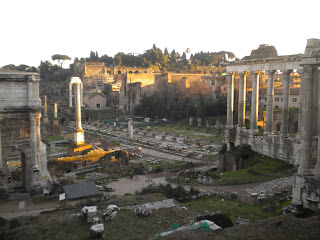John Cabot hosted a walking, guided tour during the week of orientation through Ancient Rome. This was the highlight of my first week. I thought the sites that I explored with my roommates were beautiful. But Ancient Rome doesn't even remotely compare in my opinion. Ancient Rome is a wealth of continuing beauty -- the ruins are thousands of years old, and some of the monuments have details that my Nikon simply could not do justice. Our guide attempted to shed light on the fact that all the ruins and buildings still standing were painted in colour and adorned with gold plating back in the day. My imagination could not fathom this concept. The ruins of Ancient Rome are spectacular in their white/gray/brown-ish shade. In colour, hand painted and sculpted, I cannot begin to think of what the city looked like centuries and millennia ago... Here are a few shots of what my Nikon thought were good pictures.
THE ROMAN THEATRE (AKA, the Theatre of Pompeii), a meeting place of politicians, the senate, and a place of the arts; Ceasar was thought to have been assassinated here by Cassius and Brutus....ringin' a bell Shakespeare fans???
Greek and Roman architecture
Remodeled
The Mayor of Rome's house/office; perched atop one of the 7 hills of Rome
View of the Theatre walking from the Jewish Ghetto
Next on the tour... PIAZZA del CAMPIDOGLIO, CAPITOLINE HILL; formerly home to three temples (The Temple of Juno, The Temple of Virtus, and The Temple of Jupiter). Pope Paul III Farnese commissioned Michelangelo to redesign the Piazza del Campidoglio. Check out this link (http://www.aviewoncities.com/rome/campidoglio.htm) for info that I can't retype!
One of the designers of the Renaissance remodel after Michelangelo's death;
either Carlo or Girolamo Rinaldi
Palazzo del Conservatori; one of the Capitoline museums
The "fake" statue of Marcus Aurelius; the only equestrian statue.
The original is in the museum.
The gate of the Piazza; joining sacred and political Rome in the Renaissance
SPQR; the symbol of the city. Denoted to represent the people's repulic and the power of the senate. "Chosen by the people, for the people..." --Senator Gaiuss in Gladiator
The She-Wolf; the statue of the myth of Romulus and Remus, the founding brothers of Rome, conceived by the god Mars. Check out this link (http://www.unrv.com/culture/romulus-and-remus.php) for the whole story...
Past the Capitoline square came the really old stuff... the ROMAN FORUM, 7th Century BC. This was the center of business and social outings of Ancient Rome. Decapitation of criminals were held here. Prisoners were kept in the surrounding buildings, many of which were later established as churches and temples.
Ceasar's Forum -- a small forum for Ceasar himself
Mussolini widened this road in 1929, putting half of Ceasar's Forum underground.
The road leads to the Colosseum.
St. Peter and St. Paul were thought to have been imprisoned here. It is now a church.
Down the road from Mussolini's Palace, comes the COLOSSEUM, one of Rome's most famous monuments, and most impressive in my books. The stadium for gladiator fights, constructed in AD 80, seated 50,000+ Romans, and has now come to fall to ruins. Tours still go through it, and I plan on hopefully catching one of those and updating you all with some cool facts!




















OK Sam - I have enjoyed all the pics and the comments. You should be congratulated for taking the time to comment so extensively. It brings it all back to life. You are looking rather smart in your jackets - you fit right in I think.
ReplyDeleteWhat until you see the Sistine Chapel . I hope you are not rushed. I sat down on the side and took it all in until we who were sitting were ushered on and out.
love aunt marilyn